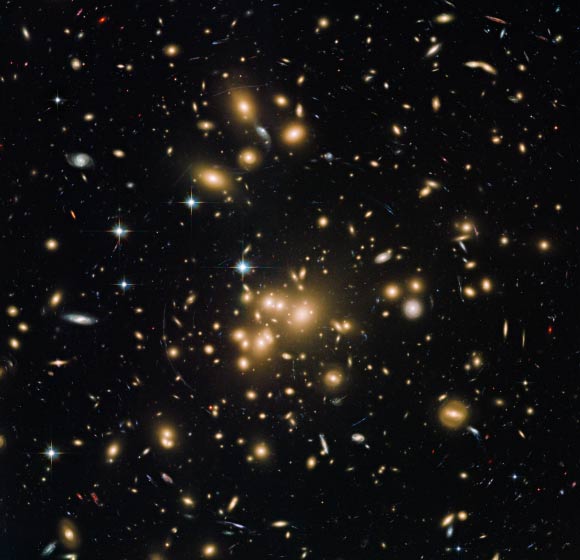New, deep observations of the massive galaxy cluster Abell 1689 have revealed that it hosts the largest population of globular clusters ever found.

This new Hubble image shows the galaxy cluster Abell 1689. Image credit: NASA / ESA / the Hubble Heritage Team / STScI / AURA / J. Blakeslee / NRC Herzberg Astrophysics Program / Dominion Astrophysical Observatory / H. Ford / JHU.
The new Hubble image is one of the best ever views of Abell 1689, and shows the phenomenon of gravitational lensing with unprecedented clarity.
Abell 1689 acts like a cosmic lens, magnifying the light from objects lying behind it and making it possible for astronomers to explore incredibly distant regions of space.
While our Milky Way Galaxy is only home to around 150 of these old clumps of stars, the Advanced Camera for Surveys aboard NASA’s Hubble Space Telescope has spied some 10,000 globular clusters within Abell 1689.
From this, astronomers estimate that this galaxy cluster could possibly contain over 160,000 globulars overall – an unprecedented number.
This is not the first time that this trusty magnifying glass has helped astronomers try to solve clues about the Universe.
In 2010, they were able to investigate the elusive phenomena of dark matter and dark energy by mapping the composition of Abell 1689. Its powers as a zoom lens also enabled Hubble to identify a galaxy dubbed A1689-zD1 in 2008, one of the youngest and brightest galaxies ever seen at the time.
The new image is peppered with glowing golden clumps, bright stars, and distant, ethereal spiral galaxies. Material from some of these galaxies is being stripped away, giving the impression that the galaxy is dripping into the surrounding space. Also visible are a number of electric blue streaks, circling and arcing around the fuzzy galaxies in the center.
These streaks are the tell-tale signs of a cosmic phenomenon known as gravitational lensing. Abell 1689 is so massive that it actually bends and warps the space around it, affecting how light from objects behind the cluster travels through space. These streaks are actually the distorted forms of galaxies that lie behind Abell 1689.







